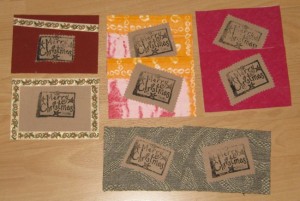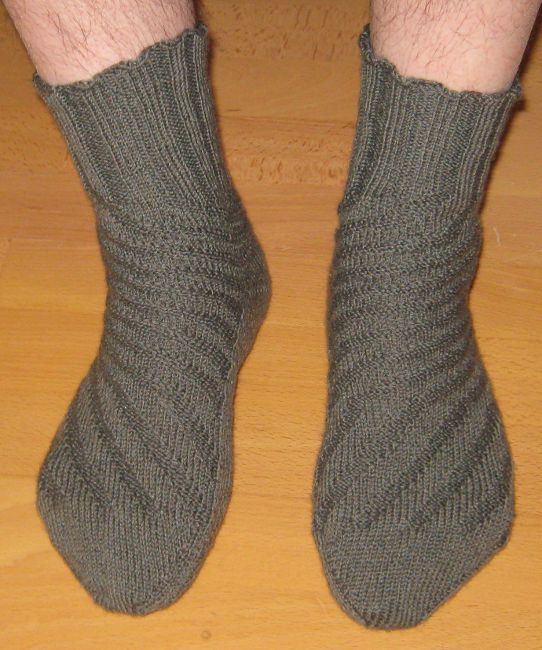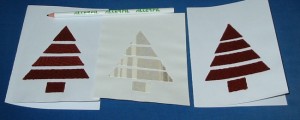Quick Textile Christmas Cards
 Dieses Jahr habe ich es endlich mal geschafft, Weihnachtskarten zu machen, die schnell gehen und gleichzeitig Stoff aufbrauchen. Und so geht es…
Dieses Jahr habe ich es endlich mal geschafft, Weihnachtskarten zu machen, die schnell gehen und gleichzeitig Stoff aufbrauchen. Und so geht es…
This year I finally reached my goal to make christmas cards that do not take ages to make and use up some of my fabric. And that’s how it goes…
Zuerst läd man mal Bärbel ein. Bärbel ist nämlich die ungekrönte Königin des Stempelns und kann einem alles verraten, was man darüber wissen will und noch ein wenig mehr. Daß sie außerdem Stempel und Stoffmalfarbe mitbringt ist ein praktischer Nebeneffekt. (Also Bärbel ist bei mir auch ohne Stempel willkommen, aber wenn sie Stempel mitbringen darf vergisst sie den Termin nicht so leicht. 😉 )
First you invite Bärbel. Bärbel is the queen of stamping and she can tell you anything about that subject you want to know and some more. That she brings the material is a nice add on. (Bärbel in generally very welcome, but she is also a very busy lady and if you promise her that stamping will on the schedule it is more likely that she will not forget the day or the time. 😉 )
Gestempelt habe ich dann auf einen schlichten Baumwoll-Canvas mit schwarzer Stoffarbe. Danach habe ich fertige Karten genommen, habe da doppelseitige Klebefolie aufgebracht und einen Basisstoff aufgeklebt. Die beiden Karten unten sind mit einem festeren Deco-Stoff „grundiert“, das dunkelrote ist ein ungefaltetes gekauftes Schrägband, das ich mal geerbt habe und das Stoß an Stoß geklebt wurde. In der Mitte eine poppigere Variante mit afrikanischem Batik Stoff. Danach wird mein gut getrockneter bestempelter Stoff ebenfalls mit der Folie beklebt, dann mit der Zackenschere ausgeschnitten und nach Lust und Laune aufgeklebt. Alles gut angedrückt hält das einfach bombig und man holt sich keine klebrigen Finger.
As base fabric for stamping I used some beige cotton canvas fabric. Stamped with colors for fabric, of course. Next step is using plastic sheet that is adhesive from both sides to bring one layer of fabric to the cards. For the two cards on the bottom I used a heavy decorators fabric, the red one on the right is cotton bias tape I’d inherited from somebodys grandmother and never used. I just stuck it edge to edge. And in the middle a more „jazzy“ version with African batic fabric. After that I applied the same double sided plastic foil to my stamped fabric, cut it with pinking shears and fixed it on top. Pressing well with fingers and it will last forever. (Okay, some years… but enough for Christmas cards. And unlike glue it doesn’t give you sticky fingers.
Die beiden Karten links sind ein bißchen anders gemacht. Bei der unteren habe ich einfach nur den bedruckten Stoff aufgeklebt und dafür noch ein bißchen Bänder von Kafka dazu geklebt, bei dem oberen habe ich den bedruckten Stoff auf den Basisstoff gelegt und beides gemeinsam geschnitten, so daß der bedruckte Stoff als „Intarsie“ eingefügt wird. Und auch da noch etwas Kafka-Band dazu. Geht ja immer.
The cards on the left were made a little differently. The one on the bottom has only the stamped fabric glued to the card and then got some more decoration with ribbons by Kafka. And for the top one I layered base fabrick and stamped fabric before cutting. So the printed fabric is not on top, but fits precicely in the cut out of the base fabric. Again some Kafka ribbon added. You never can go wrong with that.
Und jetzt habe ich Zeit, mir für meine restlichen Karten wieder was umständliches auszudenken… 😮
And now I have the time to figure out something complicated for the rest of my cards… 😮

















